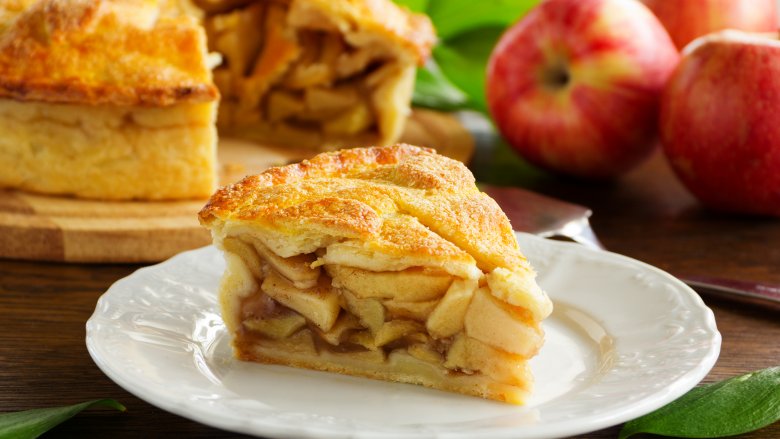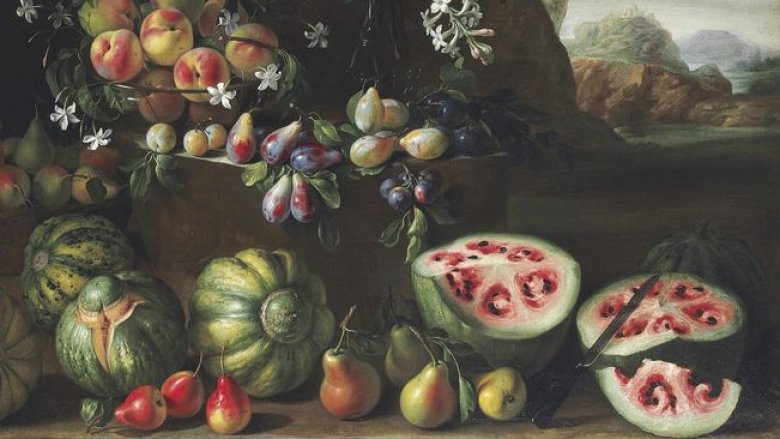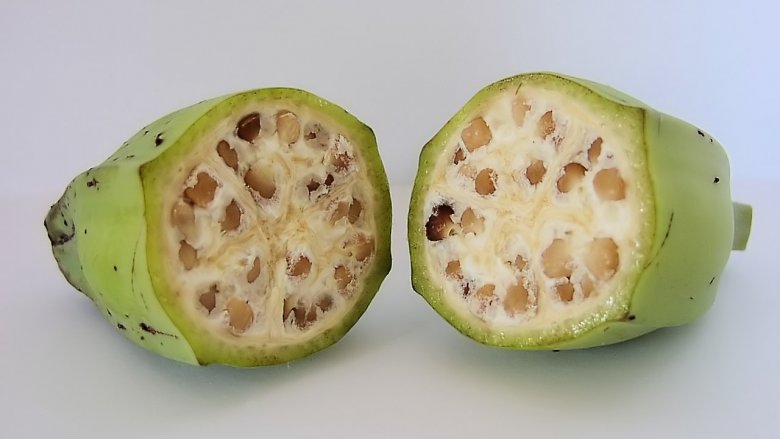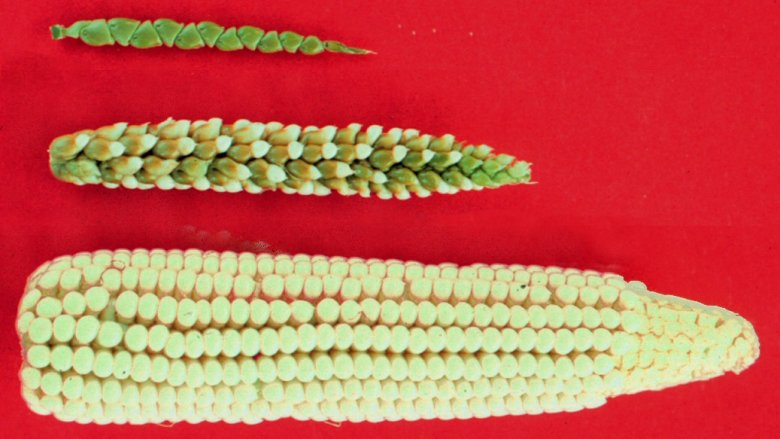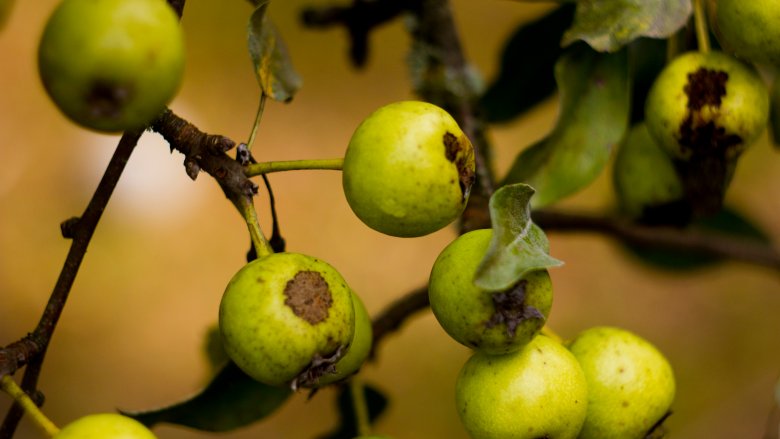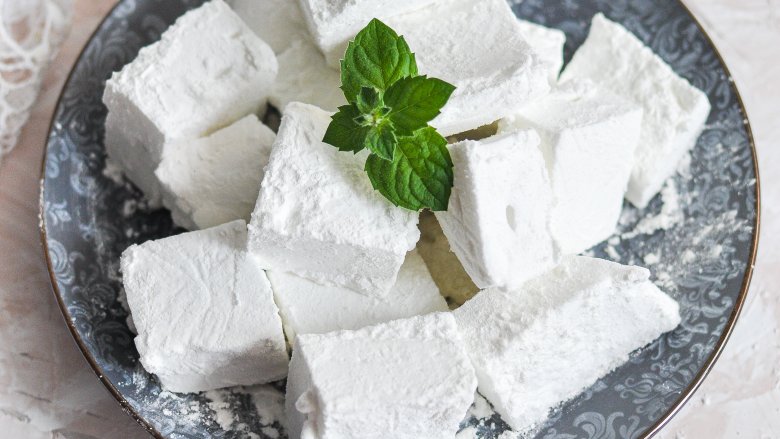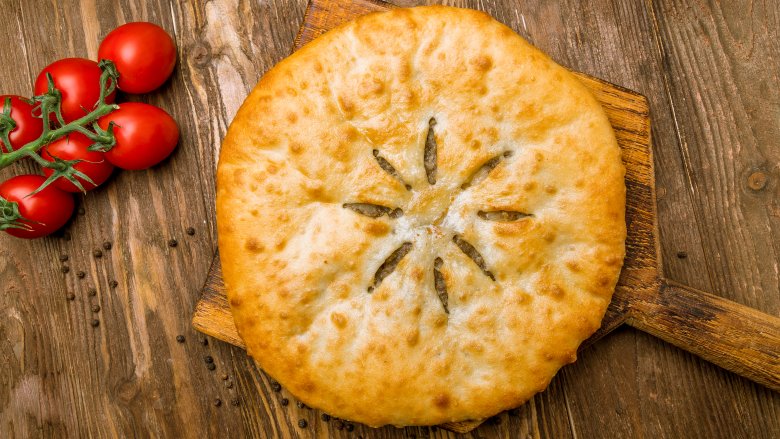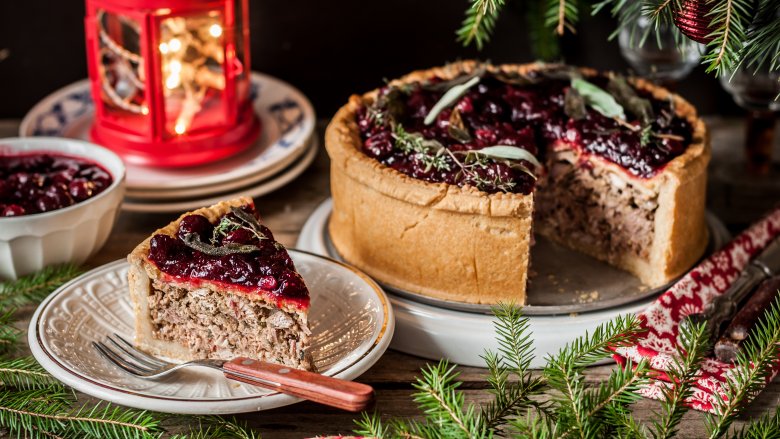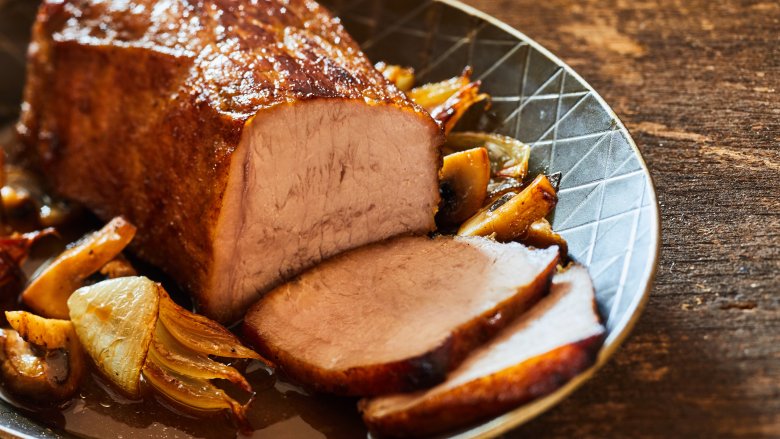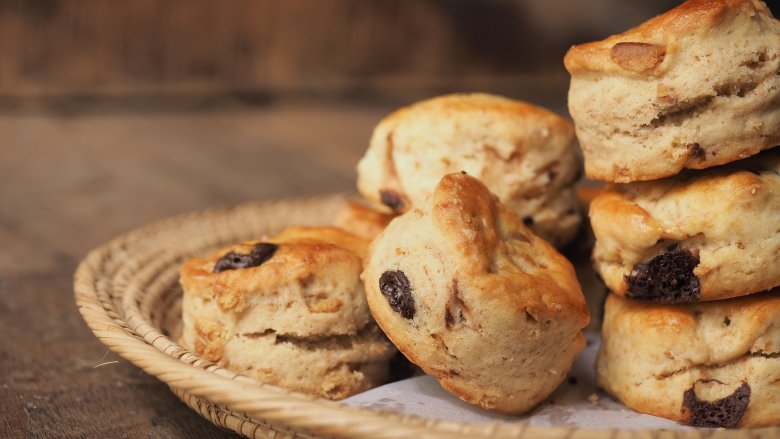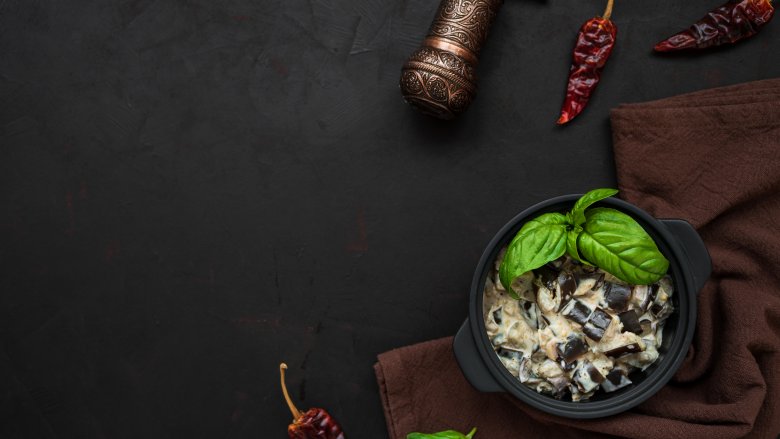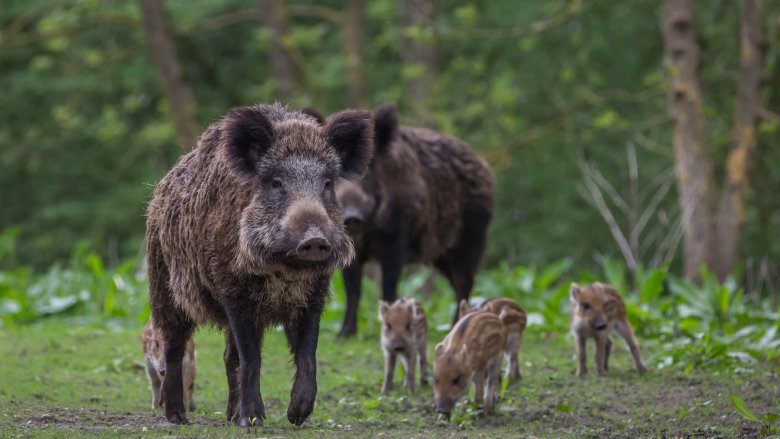Foods That Look Totally Different Today
When it comes to taking a stroll through the grocery store or ordering off a menu with no pictures, most of the time we know what we're going to get. A pie is going to be a slice of something sweet, fruity, and flaky. Curry is going to be spicy and filled with something like chicken. And meatloaf is, well, going to be ground meat shaped into a loaf. But take a look back through history, and you'll find that when our ancestors made a pie, it was completely different.
It's not just the food we make, either, it's also the food we grow. Humans have been eating fruit, vegetables, and meat for a long, long time — so long that it's evolved along the way. We've selectively bred things to give us more of the good stuff and less of the waste, and in some cases, that means we've now got something that our ancestors wouldn't even recognize.
And that's pretty wild. So, let's take a look at just what foods have changed they way they look... and prepare you for the chance someone ever develops a time machine. At least you'll know!
Hate watermelon seeds? You're out of luck
At some time between 1645 and 1672, Italian still life painter Giovanni Stanchi painted a scene with peaches, pears, and some other fruit, including a super weird-looking thing in the lower corner that was sliced into pieces. It's a good thing for us that he made that particular artistic choice, because it gives us a glimpse into what he knew as a watermelon. If you hate seeds, you'd hate 17th century watermelons.
According to University of Wisconsin professor James Nienhuis (via Vox), looking back at centuries-old artwork can provide a fascinating glimpse into what fruits and vegetables looked like before we started selectively cultivating them. Watermelon, for example, came from Africa and likely was a familiar garden staple in Europe by the 1600s. The flesh, he suspects, didn't taste much different from today's watermelon, and would have been a super sweet treat.
Over the next few centuries, gardeners started selectively breeding watermelons to have more of the bright red flesh and less of the white rind. Fun fact you can share at your next BBQ: the red part you love is actually the watermelon's placenta, and the black seeds Stanchi painted are a sign that his watermelon was fully ripened and ready to eat — even though it looks incredibly different to the watermelon cut up and served on sunny summer days today.
The holes in a banana would make your skin crawl
We all know what a banana looks like today. But if you peeled one of the wild ancestors of today's modern fruits, well, let's just say that if you suffer from trypophobia — a fear of holes — your flight response would kick into high gear. Wild bananas are, simply put, gross.
Fortunately for us, the bananas you pick up at the grocery store today have been hybridized, cultivated, and domesticated into the soft, squishy fruits we all know and love. According to ThoughtCo, it's a process that started somewhere around 13,500 to 10,700 years ago in areas like Sri Lanka and China. The oldest signs of people taking wild bananas and turning them into a legitimate crop come from Papua New Guinea, and they've likely changed form so many times it's impossible to document them all.
Strangely, it's possible we'll see another shift in the banana in the near future. The banana we eat today is the Cavendish, which Business Insider says replaced the Gros Michel in 1947 after an outbreak of the devastating Panama disease. But given that these sterile, cloned bananas are very susceptible to a new strain of fungus called Tropical Race 4, we might be on the brink of a whole new banana. Hopefully with no holes.
Corn once had spikes
Corn has come a long way since farmers in Mexico began selecting kernels from the biggest and best ears to plant for the next season. Those first steps toward domestication happened around 10,000 years ago, and according to the University of Utah, it happened surprisingly quickly.
A few theories on the domestication of corn have been put forward, but the most popular is that corn started as a genetic mutation of the teosinte, a grass that has kernels that not only look similar to corn, but that can cross-breed with today's corn and produce viable offspring. Researchers have determined that there are only five genes that are different between teosinte and corn, in spite of the difference in appearance.
ThoughtCo says wild teosinte kernels are small, hard seeds that grow in long spikes of only five to seven rows, while corn has lost those hard seeds and replaced them with husks that prevent reproduction without interference. If you hate shucking a dozen ears of corn for dinner, imagine needing to shatter the kernel of hundreds of teosinte spikes for a meal.
How 'bout these apples?
Today's apples are delicious, huge and brightly colored, ranging from super sweet to super tart. But none of these apples grew wild, and it took a ton of careful cultivation to get those varieties we take for granted every time we go to the supermarket.
According to the BBC, the ancient ancestor of Granny Smith and Honeycrisp is still out there... for now. It's called Malus sieversii, and they only seem to grow wild in the forests of Kazakhstan, where they're eaten and spread by bears. National Geographic says that's one of four likely keystone ancestors of modern apples, and they're described as very small but very sweet. A single wild tree might have a rainbow of different colored apples, and they'll even taste different.
The apples were domesticated somewhere around 3,000 to 4,000 years ago, alongside a few other varieties that grew wild along the Silk Road. Unfortunately, as they began to be cultivated for flavor, size, and uniformity, they also lost some of their tolerance for things like disease and changing climates. Going back to the forests of Kazakhstan and re-sampling some of the ancient apples that grow there might unlock new potential for breeding hardier, still-delicious apples, and we might just see another shift in this lunchtime staple.
Today's marshmallows aren't marshmallows at all
Marshmallows might seem like a weird concoction made in the modern world, but they're actually both incredibly old and, at one time, they were medicinal.
Marshmallow is actually a plant, and it was one the ancient Greeks were using to make balms, salves, lotions, and potions from as far back as the 9th century BC. Mental Floss says it was used by the ancients for everything from an anti-inflammatory and toothache treatment to a laxative.
The first ones to make candy out of it were the ancient Egyptians, but their offerings to the noble classes and the gods weren't delicious pillows of goodness, it was a mix of marshmallow sap, honey, and nuts. That... doesn't sound too bad, actually.
Marshmallows started turning into something we'd recognize around the 19th century, when French confectioners took dried marshmallow root and combined it with egg whites, sugar, and water. They sold it as a super healthy treat in bar and lozenge form, so it wasn't quite what we know today. And here's the weird thing — using extract from the marshmallow plant required drying time, so confectioners dropped the marshmallow and added gelatin. The texture and shape of today's marshmallow-free marshmallows came in the 1950s, and they're pretty much the opposite of medicinal.
Pies weren't sweet, fruity... or even edible
There's nothing quite like taking a bite of a delicious apple pie, but look back at some of the first pies and you'll find they were very different.
For starters, they were savory, not sweet. That's not too incredibly odd, as savory pies are still popular in places like Britain. But go back to the Middle Ages, and you'll find early pies weren't made with a flaky crust. The crusts weren't even edible! They were called coffyns, and the perfect coffyn was made with just flour and water, and designed to be more a vessel to serve something in than part of the dish to be eaten. They were hard vessels that would stand up on their own, and chefs would fill them with all kinds of goodness — like lamprey and crow — then seal them and use the coffyn as a sort of baking dish.
When it was served, you'd only eat whatever was baked inside. Sometimes, pies were more entertainment than food. Live birds, frogs, and the occasional person was sealed inside, then released to the delight of guests around the table, says Atlas Obscura.
They did have sweet pies in the Middle Ages, but they were called tarts and since they usually lacked sugar, they weren't all that sweet. It wasn't until the British established sugar plantations in the 18th century that pies began to — thankfully — turn into the pies we know today (via Slate).
Yes, mincemeat really was meat
Mincemeat just sounds gross, but it shouldn't. Not now, at least. Today, it's basically dried fruit, spices, and some booze for good measure, and who can't get on board with that? Today, sure, but according to the Farmers' Almanac, it really did start out as meat.
Originally, mincemeat was typically made from mutton, sugar, and alcohol, and it was basically a way of preserving the meat. It started making the shift into something else around the time of the Crusades, during the 11th century. Those returning from the Holy Land brought cloves, cinnamon, and nutmeg with them, and cooks used those spices to represent the gifts the three wise men brought Jesus in the manger — that's why we still think of those as traditional Christmas-time spices. Mince pies were made with meat and those three spices (and topped with a little edible Jesus, because people have always been weird.)
Mincemeat got a little more varied through the 15th to 17th centuries, when dried fruit was added to the meat and vinegar — sometimes wine — was the liquid of choice. That was replaced by brandy in the 1900s, and while it was a staple of good ol' country cookin', it stayed a Victorian-era Christmas tradition, too. The change, What's Cooking America notes, came mostly because fruits and spices became more readily available around the 17th century, and it wasn't until the mid-20th century that we got rid of the meat altogether.
Meatloaf used to be... brainy
Meatloaf has been around for a long time, and no matter how much you might love Grandma's Famous Meatloaf, you probably would have hated Great-Great-Etc.-Grandma's Famous Meatloaf.
According to Twisted, one of the very first dishes we might recognize as meatloaf dates all the way back to ancient Rome. Buried in a collection of recipes is one that describes making patties out of meat, bread, spices, and wine, which all sounds fine until you consider that it also called for various kinds of cooked brains. It was also shaped into patties, not a loaf, so there's that.
Between ancient Rome and the Industrial Revolution, meatloaf was a dish that allowed cooks to make sure nothing went to waste. It was the hot dog of its time, filled with all kinds of bits of the animal that couldn't be used elsewhere. People started getting more creative once they had meat grinders in their homes, and throughout the 19th century, they were eating meatloaf... for breakfast.
The rise of the meatpacking industry in the 1890s meant there were even more scraps up for grabs, and meatloaf continued to be pretty scrappy. It was perfect for tough times, like the Depression and during World War II, says Bon Appetit, and people threw in everything from offal to cereal. Order meatloaf off a 1950s menu and you just might get served something with ketchup-filled peach halves. Thankfully, we're not living in the '50s anymore.
Wedding cakes weren't very photo-worthy
The idea of serving a wedding cake at a wedding is surprisingly old, and it's a tradition that dates back to at least ancient Rome. But according to Gastonomica, ancient Roman wedding cakes weren't the same sugary towers of icing and fondant flowers that grace center tables today.
They were originally "cakes" made from wheat or barley, and they were along the lines of a modern scone. They actually played a major part in the ceremony: the marriage was finalized when the cake was broken over the bride — it was thought to be a way of bestowing good fortune on them — and then, as their first act as a married couple, they ate a bit together. Guests later gathered up the crumbs — all for good luck — and gradually, the tradition shifted a bit and the cakes became a little sweeter.
By the Middle Ages, wedding cakes had changed quite a bit but still were nothing like today's. English wedding cakes were often a tower of sweet buns, and if the happy couple could kiss over the top of it, their future was thought to be a prosperous one. The very first recipe ever found written as a "wedding cake" was actually a "bride's pye", and that was a very literal pie filled with things like oysters, rooster's combs, and lamb's testicles. That was in 1685, and fortunately, things have changed since then — largely thanks to an increasing availability of sugar.
Here's your next curry
Curry is delicious, and it's one of those things that if you're not eating it regularly, you should be. Today, it's usually made with chicken or beef, and it's got a ton of spice and a creamy sauce thanks to tomatoes, cream, yogurt or coconut milk. Early curry? Not quite the same.
Archaeology is a pretty neat thing, and it's incredible what we can learn these days. According to the BBC, researchers working at the excavation site of Farmana in India applied some very cool science to their findings. They took 4,000-year-old pots, analyzed the starch molecules, then compared them to the starchy markers left behind by various foods. Among the things they found was the recipe for what was essentially the first curry — or, at least, the first we've found so far. There were only four ingredients: eggplant, turmeric, ginger, and salt, and while that's a far cry from today's curry, at least you can still make it!
Here's the neat thing: they also found traces of plenty of other foods available at the the same time as that first eggplant curry, and suggest making your own proto-curry by adding cumin, sesame oil, and a bit of diced mango.
Wild boars would one day become bacon
When it comes to milestones in the development of humankind, the shift from hunting and gathering to domestication and agriculture is a pretty big one. Archaeologists and historians are still a little unclear about just how that all happened, but they are fairly certain pigs were domesticated early on, and independently in different areas. Humankind was living alongside — and eating — pigs around 10,000 years ago, and people in Eastern Turkey seem to have been the first to do it.
The pigs that first made our ancestors say, "Hey, that looks tasty, I bet I can pet that," were nothing like the modern pigs we put in teacups, photograph for Instagram, then make into bacon sandwiches. According to The Conversation, researchers have been able to trace modern pig DNA back to their wild boar ancestors. Different pigs have been linked to different wild boar populations, but comparing 6,000 year old skulls from pigs and wild boars show that already, the domesticated versions were getting smaller and — presumably — more docile and easier to handle, with tusks that got smaller and smaller.
Just how domestication happened is still debated, but ThoughtCo says it's generally agreed that some hunters might have started realizing it was easier to keep pigs at home than go looking for them, and started breeding the ones with better dispositions. Eventually, those more docile pigs created lines of piglets that were even more docile than the last, eventually giving us the pigs we know (and love to eat) today.
